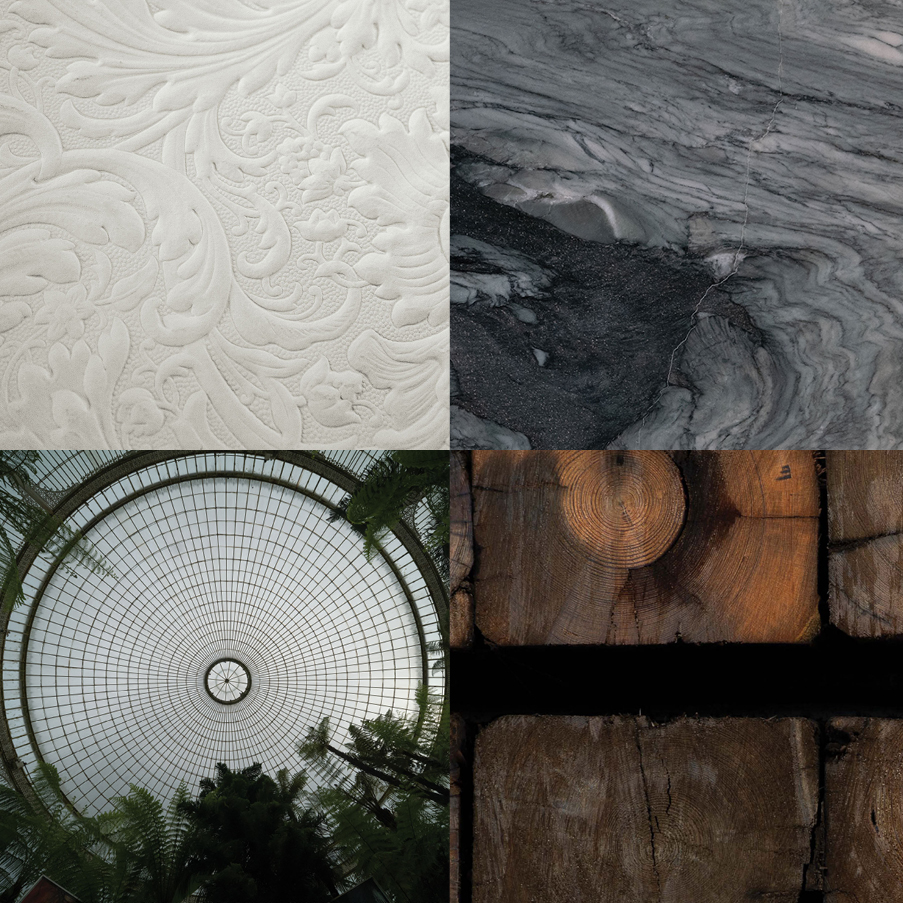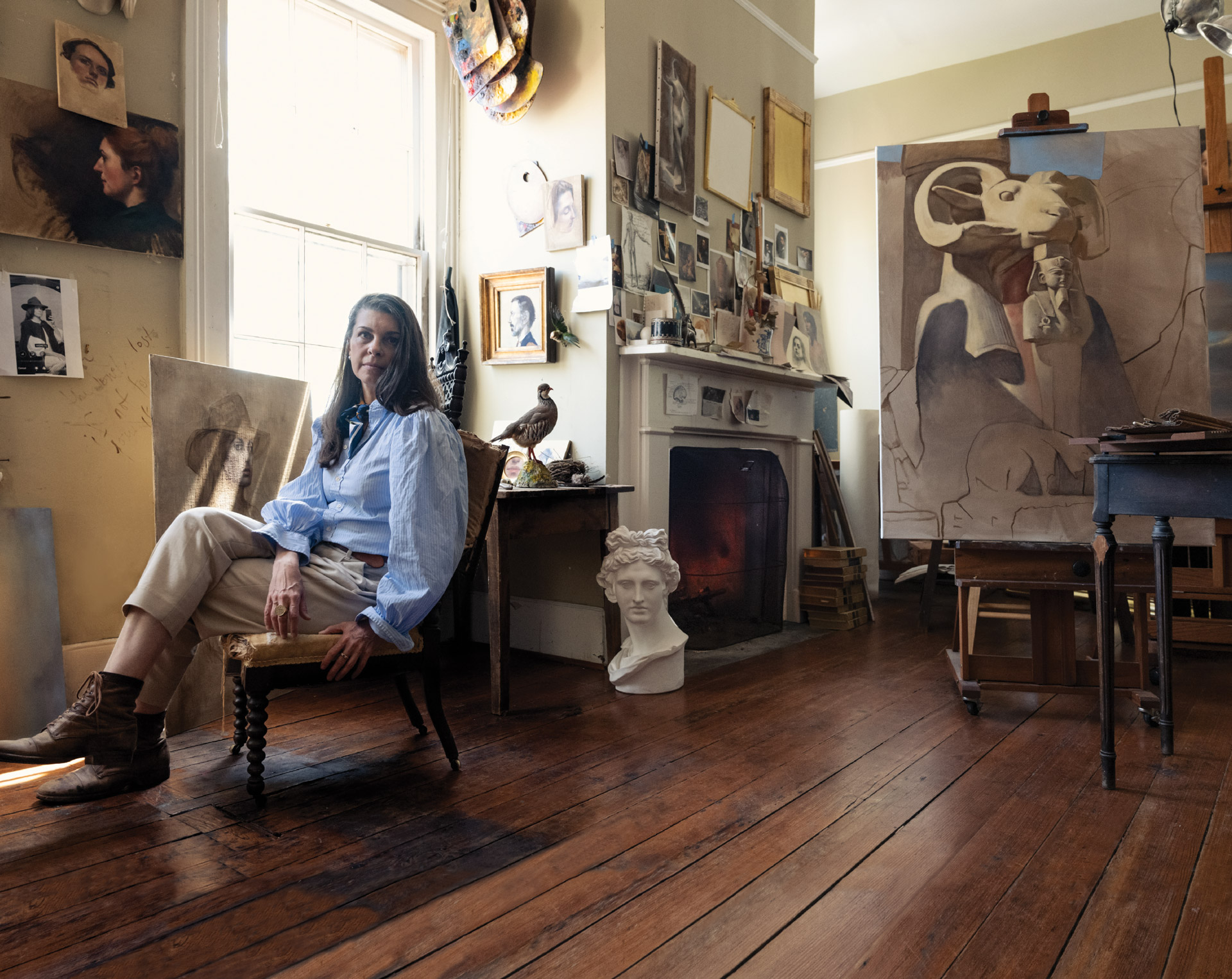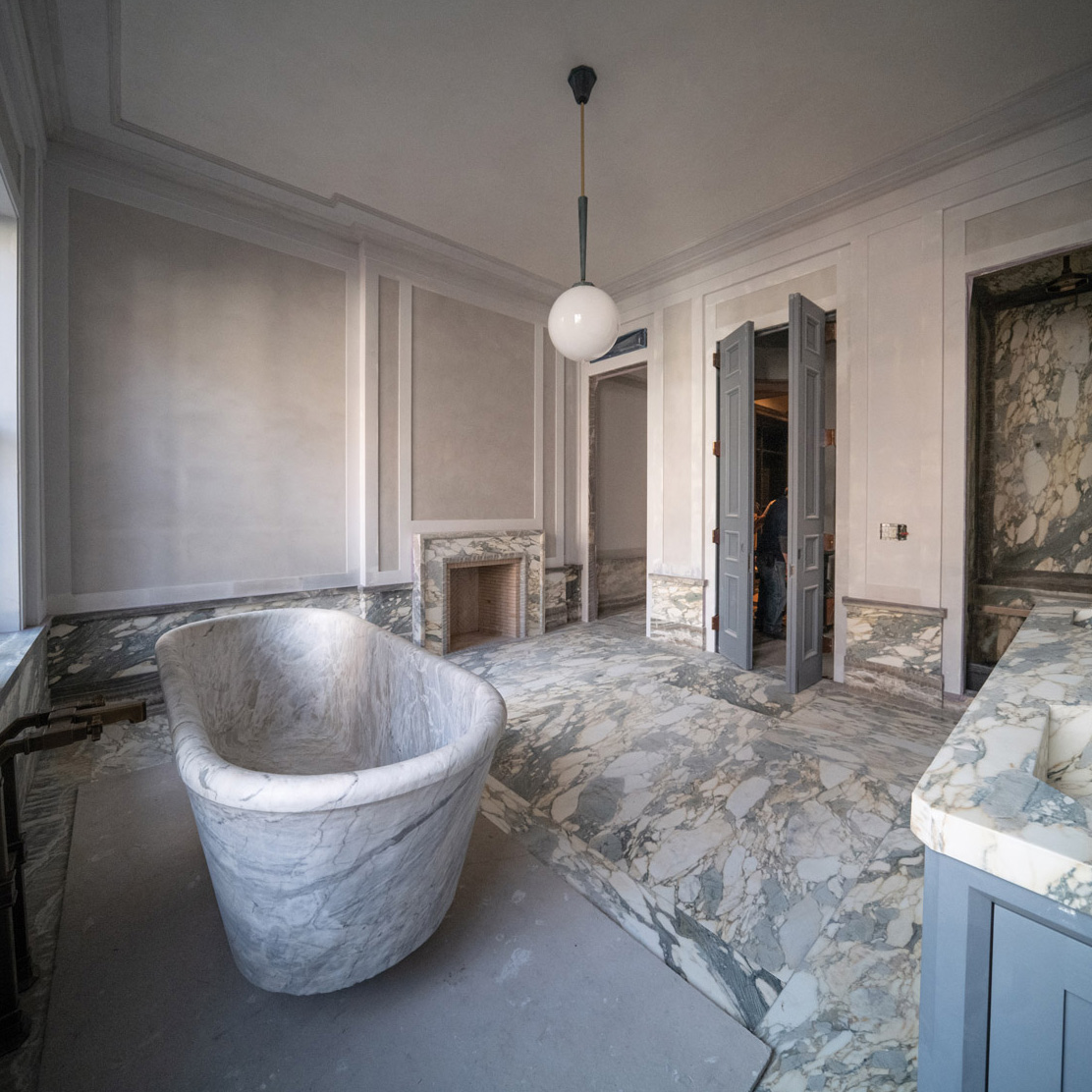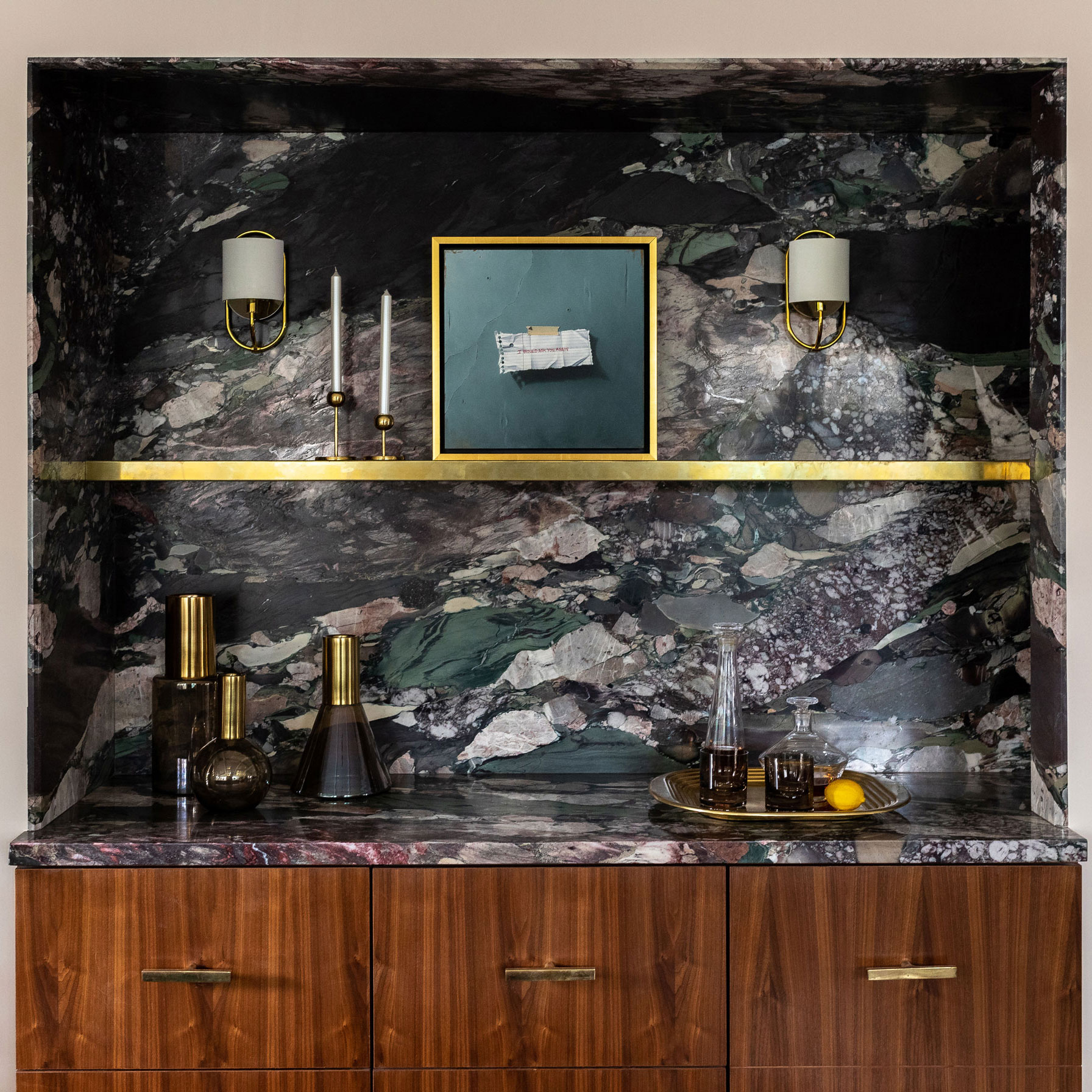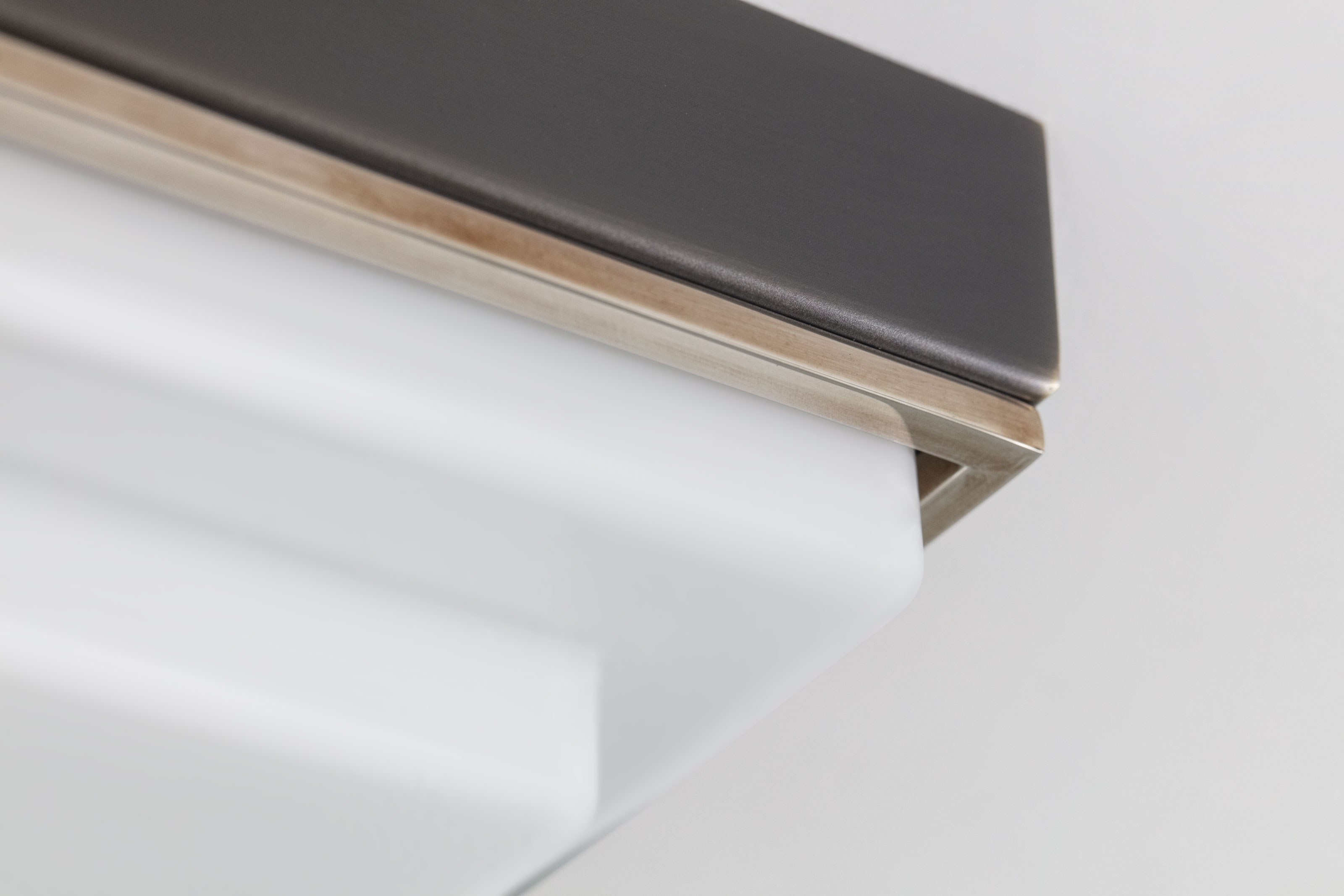ROCK
of
AGES
On the trail of ancient quarries, pharaonic feats and Earth's most imperial material with Marmi’s charismatic chief, Magd Riad.
A journey from
CAIRO
to
CARRARA
and beyond
G
Gone is the limestone pyramidion coated in gold, the ultimate quadrilateral crown that reflected the rays of heaven. Gone is the gleaming skin of polished limestone from the quarries in Tura that turned pure geometry into a blinding desert iceberg. What remains, though, is the largest ever pile of stone, the core of the Great Pyramid of Khufu (Cheops) at Giza, Egypt, the oldest and only survivor of the Seven Wonders of the World. For nearly 4,000 years it stood as the tallest man-made structure on Earth. Aside from limestone for the main building blocks, the pyramid was larded with other stone: basalt from the Fayum Depression and alabaster from Hatnub near Luxor and red granite from Aswan lining the walls of the King’s Chamber.
Right
Though Giza has grown up around the Great Pyramids, from certain approaches the view is as old as the monuments themselves.
Though Giza has grown up around the Great Pyramids, from certain approaches the view is as old as the monuments themselves.
BELOW
Though Giza has grown up around the Great Pyramids, from certain approaches the view is as old as the monuments themselves.
Though Giza has grown up around the Great Pyramids, from certain approaches the view is as old as the monuments themselves.
STONE UPON STONE UPON STONE.
This massive pile rests on the Mokattam Formation, a plane of limestone solid and stable enough to support the weight of 2.3 million blocks, each weighing on average two and a half tons. As staggering as this weight of blocks is, it’s the pace of construction that is dizzyingly incomprehensible. According to Egyptologist Toby Wilkinson, “builders would have had to set one 2.5-ton block of stone in place every two minutes during a ten-hour day, working without pause throughout the year for the two decades of Khufu’s reign (c. 2545-2525 BC).” The ancient Egyptians were impressive record-keepers, both in stone and on papyrus, yet for all we know about 30 dynasties across 3,000 years, there remain profound mysteries. The Great Pyramid is perhaps the most iconic example: how did builders choose a site and know that what lay underground was strong enough to support such a colossal weight? How did they manage to orient the monumental form to true north and be off by only one twentieth of one degree? How did they not only physically put the blocks in place (and move them from the quarry) but cut the outer blocks so precisely that not even a knife blade could slip between the joints? In many ways, ancient Egyptians put the civilized into civilization.
One thing we know with absolute certainty: stone was as elemental to the ancient world as broadband is to ours. For Egyptians, the afterlife was paramount. If you wished something to last for eternity, you chose stone. Or as an Arab proverb succinctly puts it, “man fears time, but time fears the pyramids.”
One thing we know with absolute certainty: stone was as elemental to the ancient world as broadband is to ours. For Egyptians, the afterlife was paramount. If you wished something to last for eternity, you chose stone. Or as an Arab proverb succinctly puts it, “man fears time, but time fears the pyramids.”
RIGHT
Layers of stone at Saqqara.
Layers of stone at Saqqara.
TOP
Layers of stone at Saqqara.
Layers of stone at Saqqara.
“man fears time, but time fears the pyramids.”
MIDDLE
Immense blocks of polished limestone once clad the Great Pyramid of Khufu.
Immense blocks of polished limestone once clad the Great Pyramid of Khufu.
TOP LEFT
Immense blocks of polished limestone once clad the Great Pyramid of Khufu.
Immense blocks of polished limestone once clad the Great Pyramid of Khufu.
LEFT
The immense enclosure wall at Saqqara, with its endless niches, is as impressive as its stepped pyramid, the first built in Egypt.
The immense enclosure wall at Saqqara, with its endless niches, is as impressive as its stepped pyramid, the first built in Egypt.
TOP RIGHT
The immense enclosure wall at Saqqara, with its endless niches, is as impressive as its stepped pyramid, the first built in Egypt.
The immense enclosure wall at Saqqara, with its endless niches, is as impressive as its stepped pyramid, the first built in Egypt.
CAIRO
Stone is also fundamental to the life of Magd Riad, who would appear to fear nothing except for a dull time. As president of Marmi, a major supplier/fabricator/installer of all kinds of stone for architects and designers in the United States, Magd travels the world to find just the right blocks and slabs for his clients.
LEFT
A row of cobras rises up to greet the great stepped pyramid at Saqqara.
A row of cobras rises up to greet the great stepped pyramid at Saqqara.
He may deal in all that’s hard and heavy, but you’ll not find a lighter, softer, more affable and entertaining fellow—his animated face is the antithesis of the stern pharaonic visage.
Magd was born in Egypt, and though he has lived in the U.S. for most of his life, his trips back are frequent, both to visit his father, an energetic retired general, and as an ambassador for his native country. He has put together innumerable trips to Egypt for loyal clients, who inevitably become friends and for friends, like Urban Electric’s Dave Dawson, who become clients. As Magd introduces them to all things Egyptian, he too learns new tidbits because ancient Egypt, it turns out, is a land of surprises and discoveries.
At the necropolis of Saqqara, for instance, recent revelations keep coming: in 2018, the 4,400-year-old tomb of royal priest Wahtye; in 2019, hundreds of statues and mummified animals; in 2020, 52 burial shafts with more than 50 wooden coffins dating back 3,000 years and the funerary temple of Queen Nearit, the wife of King Teti, the first pharaoh of the Sixth Dynasty of Egypt. And as recently as this past spring, five stone tombs of high-ranking officials that are even earlier, from the Old Kingdom (c. 2700–2200 BC) and First Intermediate (c. 2181–2055 BC) eras. Yet, of all of the treasure that has been unearthed over the past few centuries, it represents scarcely a third of what lies below.
Magd was born in Egypt, and though he has lived in the U.S. for most of his life, his trips back are frequent, both to visit his father, an energetic retired general, and as an ambassador for his native country. He has put together innumerable trips to Egypt for loyal clients, who inevitably become friends and for friends, like Urban Electric’s Dave Dawson, who become clients. As Magd introduces them to all things Egyptian, he too learns new tidbits because ancient Egypt, it turns out, is a land of surprises and discoveries.
At the necropolis of Saqqara, for instance, recent revelations keep coming: in 2018, the 4,400-year-old tomb of royal priest Wahtye; in 2019, hundreds of statues and mummified animals; in 2020, 52 burial shafts with more than 50 wooden coffins dating back 3,000 years and the funerary temple of Queen Nearit, the wife of King Teti, the first pharaoh of the Sixth Dynasty of Egypt. And as recently as this past spring, five stone tombs of high-ranking officials that are even earlier, from the Old Kingdom (c. 2700–2200 BC) and First Intermediate (c. 2181–2055 BC) eras. Yet, of all of the treasure that has been unearthed over the past few centuries, it represents scarcely a third of what lies below.
EGYPT
(Clockwise from TOP left) Ongoing excavations at Saqqara continue to deliver treasure. The door to the afterlife, Princess Idut’s tomb at Saqqara. LONGTIME URBAN ELECTRIC DOCUMENTARIAN ANNE CHANDLER WITH MAGD RIAD, PRESIDENT of marmi.
...for all of the treasure that has been unearthed over the past few centuries, it represents scarcely a third of what lies below...
Magd is no less a wizard at harvesting stone than he is at hosting visitors to his native land. Witness his arranging the trip's guide and guiding light, Egyptologist extraordinaire Fatma Abdalla. Armed with deep knowledge, unflagging enthusiasm and a brilliance in storytelling, she keeps us intrigued and entertained. If our focus strays, she corrals the wayward with a cheery “yallah!”; when all is understood, she proclaims “voila!”
To demonstrate the 54-degree “angle of repose” that the pyramids assume, Fatma gathered a handful of sand and let it leak slowly from her tightly closed fist. The pile it formed was the perfect pyramid, a simple illustration of nature as a design force. No wonder Fatma is equally adored by clients, curators, colleagues, security guards and common Egyptians who take pride in their history. Though she appeared only briefly on the telecast of the Pharaoh's Golden Parade, a grand procession celebrating the transfer of 22 royal mummies from the Egyptian Museum to the National Museum of Egyptian Civilization, she was greeted the next day like a conquering hero. It seems all of Egypt had seen her on TV. For a guide with 32 years of experience, it was welcome recognition.
To demonstrate the 54-degree “angle of repose” that the pyramids assume, Fatma gathered a handful of sand and let it leak slowly from her tightly closed fist. The pile it formed was the perfect pyramid, a simple illustration of nature as a design force. No wonder Fatma is equally adored by clients, curators, colleagues, security guards and common Egyptians who take pride in their history. Though she appeared only briefly on the telecast of the Pharaoh's Golden Parade, a grand procession celebrating the transfer of 22 royal mummies from the Egyptian Museum to the National Museum of Egyptian Civilization, she was greeted the next day like a conquering hero. It seems all of Egypt had seen her on TV. For a guide with 32 years of experience, it was welcome recognition.
Fatma relayed information about pharaohs and deities, symbols and glyphs, architecture and painting, as well as about stone. In the Egyptian Museum at Tahrir Square, she made a beeline to the Narmer Palette, a finely carved ceremonial palette of gray-green siltstone dating from the 31st century BC.
Even better known than the Narmer Palette is the Rosetta Stone, a stele carved of granodiorite that exists in the Egyptian Museum only in replica. The original Rosetta Stone, prized for providing the key to deciphering hieroglyphs, lives (like the Elgin Marbles) in the British Museum.
There will finally be space enough to put on display all of the treasure that emerged from the tomb of a minor pharaoh, Tutankhamun. One can only imagine the embarrassment of riches that were robbed from the tomb of Ramesses II, a pharaoh who reigned 56 years longer than Tut.
Cited as the first historical document in the world, it is thought to mark the creation of Egypt by depicting, in some of the earliest hieroglyphs, the unification of Upper and Lower Egypt under King Narmer.
However, the building of a monumental new showcase, in this case the Grand Egyptian Museum (GEM), makes an argument for repatriation. After multiple delays, GEM is opening this year as the largest archaeological museum complex in the world.
Leave no stone unturned
At times the talk of stone between Fatma and Magd was like call and response, each filling in the other’s gaps in knowledge. But in the Cairo stone yard of Marmi, Fatma surrendered her guide cap to Magd and to the company owners: the Abdalla family (no relation to Fatma). Between their two sites in Cairo and 40 quarries, the Abdallas have for 50 years been quarrying, sawing, polishing and processing more than 250 types of stone: primarily granite and marble but also onyx, alabaster, quartzite, travertine…the list goes on.
LEFT
Magd Riad inspects a “carpet” of many marbles at Marmi in Cairo.
Magd Riad inspects a “carpet” of many marbles at Marmi in Cairo.
“Stone is like jewelry,” says Claude Abdalla, the family patriarch. “It can be common or rare but the strong colors—greens and reds— are like emeralds and rubies.” And as with contemporary gems, stone here is cut using, well, cutting-edge technology. Ancient meets advanced, with granite from the oldest continually operating quarry in the world, in Aswan, submitting to the diamond blades of a 21st century Italian gangsaw from Gaspari Menotti. Where it once took nearly a week to saw one block into slabs, now 60 slices can be cut in six hours.
Marmi is a vast sampler of all that can be done with stone. Cut one way, a block of Egyptian alabaster yields slabs in a stripey linear pattern; rotated 90 degrees and cut another, the slabs burst into cloudlike blooms. For a memorial, lasers deeply etch calligraphic Arabic. A multi-colored carpet-sized slab reveals itself, on closer inspection, to be a composite of hundreds of different marbles cut and assembled to mimic an Azerbaijan rug. By the offices, a slab of Imperial Grey marble captures, in graphic Ed Ruscha lettering, Euripides’s dictum, “leave no stone unturned.” At Marmi, not a chance.
Marmi is a vast sampler of all that can be done with stone. Cut one way, a block of Egyptian alabaster yields slabs in a stripey linear pattern; rotated 90 degrees and cut another, the slabs burst into cloudlike blooms. For a memorial, lasers deeply etch calligraphic Arabic. A multi-colored carpet-sized slab reveals itself, on closer inspection, to be a composite of hundreds of different marbles cut and assembled to mimic an Azerbaijan rug. By the offices, a slab of Imperial Grey marble captures, in graphic Ed Ruscha lettering, Euripides’s dictum, “leave no stone unturned.” At Marmi, not a chance.
granite from the oldest quarry in Egypt meetS the modern world in a sculpture by STEPHEN COX.
Like fingerprints, each slab cut from a block has a unique identity.
MAGD with CLAUDE ABDALLA'S SON, GEORGE.
Saws with diamond chains slice through marble and granite.
Maneuvering stone takes as much skill as cutting it.
A five-ton block of marble being cut into slabs.
LUXOR
For major building projects, the ancient Egyptians primarily used limestone and sandstone. Karnak sits in modern day Luxor (ancient Thebes) at the juncture of the two stones, with sandstone predominating as you move south. As monumental as the Great Pyramids are, Karnak is an architectural masterpiece, a demonstration of Egyptian construction prowess more complex than mighty.
LEFT
Rows of rams-head sphinxes, each protecting a pharaoh between its paws, flank the approach to the necropolis at Karnak.
Rows of rams-head sphinxes, each protecting a pharaoh between its paws, flank the approach to the necropolis at Karnak.
The largest temple in the world (the Vatican of its day), it dwarfs St. Peter’s Basilica in Rome. Over the course of 2,000 years, thirty successive pharaohs worked and reworked this complex on the east bank of the Nile.
Opposing rows of rams-head sphinxes followed by a vast forecourt lead to the Great Hypostyle Hall. A forest of 134 massive sandstone columns cresting in papyrus blossom capitals presents a cathedral of light and shadow, dwarfing travelers who play peek-a-boo around the column bases. So supercharged is the scale that fifty people could stand together atop a capital. Every surface is embellished, either inscribed or carved into bas-relief, and with the largest columns reaching 69 feet high with a girth of 33 feet, the surface area is considerable. So all-encompassing is the decoration that it fairly disguises the seams between the massive disks of stone stacked to form the columns. Again, how did they build them?
What reveals itself more slowly than the magnificence of scale or the generations of bas-reliefs and inscriptions is the coloration. Just as the Acropolis was never white but in fact a highly polychromed temple, so too was Karnak not a sea of pale brown that blended into the landscape.The bright and deep colors that adorned the columns are less worn by time than hidden by dust and sand. When the columns are periodically cleaned, yellows, reds, blues and greens bring cartouches, figures and animals vividly to life.
Opposing rows of rams-head sphinxes followed by a vast forecourt lead to the Great Hypostyle Hall. A forest of 134 massive sandstone columns cresting in papyrus blossom capitals presents a cathedral of light and shadow, dwarfing travelers who play peek-a-boo around the column bases. So supercharged is the scale that fifty people could stand together atop a capital. Every surface is embellished, either inscribed or carved into bas-relief, and with the largest columns reaching 69 feet high with a girth of 33 feet, the surface area is considerable. So all-encompassing is the decoration that it fairly disguises the seams between the massive disks of stone stacked to form the columns. Again, how did they build them?
What reveals itself more slowly than the magnificence of scale or the generations of bas-reliefs and inscriptions is the coloration. Just as the Acropolis was never white but in fact a highly polychromed temple, so too was Karnak not a sea of pale brown that blended into the landscape.The bright and deep colors that adorned the columns are less worn by time than hidden by dust and sand. When the columns are periodically cleaned, yellows, reds, blues and greens bring cartouches, figures and animals vividly to life.
EGYPT
(Clockwise from TOP left) The carvings and coloration of columns at Karnak are remarkably vivid, especially when cleaned of sand and dust. Papyrus-shaped columns were constructed of massive disks of sandstone. A granite doorway frames a view of a well-preserved column. 134 columns make up the Great Hypostyle Hall at Karnak. A statue of A King amid the palms.
An Egyptian with the Ministry of State for Antiquities has described Karnak as an archaeological ocean the surface of which scholars have barely dipped below. The same could be said of the Valley of the Kings and the Valley of the Queens, across the Nile from Karnak, where virtually all treasure lies beneath.
None are more vivid and beautiful than those in the tomb of Nefertari, often cited as the Sistine Chapel of ancient Egypt. Her tomb is a testament, like the Taj Mahal, to eternal love, that of Pharaoh Ramesses II for his first and favorite queen, “the one for whom the sun shines.”
For all of their liberal application of bright colors, painters made heavy use of black outlining, much as the kings, queens and notables dramatically accentuated their eyes, eyebrows and lashes. Once again, stone comes into play, in its minutest form.
The valleys are shielded by dry and dusty mountains snaked with forking paths, punctuated by deep portals to tombs. Just as impressive as the construction of monuments above ground is the extensive tunneling & hollowing out of rooms, all accomplished thousands of years ago using bronze chisels and adzes. Steep ramps & stairways in narrow tunnels deliver great reward: rooms embellished wall to wall to ceiling with striking paintings.
Beneath a deep blue sky of a thousand painted stars, the richness of the afterlife and the beauty of Nefertari herself are rendered in exquisite and vibrant detail across 5,200 square feet of plastered surface. The intensity of colors more than 3,000 years old is due to mineral-based pigments.
Makeup was derived from azurite and malachite ground to a fine powder for eye shadow and soot combined with the mineral galena to produce kohl for the heavily-lined eye synonymous with Cleopatra. Black shading both made for striking eyes and protected from glare. Think football players and Friday night lights.
THE
In contrast to the valley’s tombs—their heat and dust and the abundance of stone—the Nile brings a fluid gracefulness to this hard-edged land. The longest river in Africa, waterway of legend and civilization’s birth, the Nile is lifeblood to Egyptians, making irrigation, transit and tourism possible. And for travelers like us, its rich green banks and placid waters refresh and restore.
LEFT
The lateen sail of a felucca catches a breeze on the Nile.
The lateen sail of a felucca catches a breeze on the Nile.
Antony and Cleopatra honeymooned on the Nile in a gilded barge, but for modern day travelers, dahabiyas, with their limited number of cabins (8-10) and shallow draft, offer the most intimate and comfortable way to cruise the river, and none is nicer than the Eyaru, a new vessel low on kitsch and high on authenticity and amenities. Osama Boshra not only manages the boat but designed every feature down to the dining chairs with their lion legs, the tableware made in the pottery town of Garagos and djellabas of crisp cool Egyptian cotton for sale in support of single-mother seamstresses. At the buffet, traditional dishes like koshary and bamia bil lahma are always accompanied by Shamsi bread (traditional loaves left to rise in the sun), the very same as the offerings depicted in the wall paintings of Nefertari’s tomb.
Typical dahabiya tours cruise the Nile for three to four nights from Luxor to Aswan or vice versa. Though a far cry from the three months early tourists devoted to their Egyptian sojourns, our few days onboard are spent in much the same way, languidly touring sites not reached by bigger boats, napping, reading, playing backgammon, feasting and taking in the unfolding panorama of the shoreline. Atypically, this was a fast cruise to Aswan, though it afforded downtime in the cabins and deck-time digesting all of the insights gleaned from Fatma. We basked in Magd’s entertaining ways and observed painter Jill Hooper render quick watercolor landscapes. A lucky few even took a stab at painting under her tutelage.
Typical dahabiya tours cruise the Nile for three to four nights from Luxor to Aswan or vice versa. Though a far cry from the three months early tourists devoted to their Egyptian sojourns, our few days onboard are spent in much the same way, languidly touring sites not reached by bigger boats, napping, reading, playing backgammon, feasting and taking in the unfolding panorama of the shoreline. Atypically, this was a fast cruise to Aswan, though it afforded downtime in the cabins and deck-time digesting all of the insights gleaned from Fatma. We basked in Magd’s entertaining ways and observed painter Jill Hooper render quick watercolor landscapes. A lucky few even took a stab at painting under her tutelage.
NILE
(Clockwise from TOP left) A riverbank view unchanged for millennia. The Nile is a linear oasis of palms and greenery. Harvesting WHEAT along the riverbanks.
Aswan is where dahabiyas share the waters with a flotilla of feluccas, the traditional wooden sailboat rigged with lateen sails. The cluster of boats with sails hoisted created a view as seen from the terrace of the Old Cataract Hotel that could be cast in sepia, so closely does it recall the Agatha Christie golden age of travel on the Nile in the early 20th century.
Aswan granite was second only to sandstone and limestone as the most important stone used by ancient Egyptians, who used it for the smallest vases to colossal statues and obelisks. Carved from a single block of red granite, towering obelisks were erected in front of temples, usually in pairs, as guardians and in recognition of the value Egyptians placed on balance and harmony.
Whether apocryphal or not, Josephine’s directive to Napoleon, “if you go to Thebes, do send me a little obelisk,” confirms the esteem accorded the form. Not one for small gestures, Napoleon's campaign delivered. A 75-foot-tall obelisk from the pair that Ramesses II originally erected at the temple at Luxor now guards the Place de la Concorde in Paris.
Here we made our last stop in Egypt—a Marmi quarry nearby that is so fully situated in the heart of town that it can’t operate during school hours so as not to disturb the students next door. In the quarry, men were drilling deep parallel holes in order to release a chunk of stone from the mass, a technique much the same as ancient times, except pneumatic tools dramatically hasten the job.
Given the length and weight of the stone needles and the difficulty in erecting them—how that was achieved in ancient Egypt is still a matter of speculation—the degree to which they have migrated to distant shores is astounding. London and New York each have a Cleopatra’s Needle.
ASWAN
But Rome is where one finds the lion’s share (or pharaoh’s share) of obelisks from ancient Egypt, not surprisingly, given that Rome annexed Egypt in 30 BC
LEFT
Obelisk at Karnak Temple,Luxor, Egypt.
Obelisk at Karnak Temple,Luxor, Egypt.
Eight in total pin down some of the most significant piazzas in the Eternal City: Piazza del Popolo, St. Peter’s Square, Piazza di San Giovanni in Laterano, Piazza della Rotonda. Tasked with the job of erecting the 357-ton obelisk at St. Peter’s, Renaissance architect Domenico Fontana employed no less than 75 horses, 900 men and an endless supply of rope and pulleys.
Roman taste in stone though leaned heavily to marble, and for that they discovered quarries in their own backyard–the Apuan Alps in northern Tuscany. Nothing rivaled the purity of the white marble, Statuario, found here. For Michelangelo, it was the marble of his dreams, “of compact grain, homogeneous, crystalline, reminiscent of sugar,” and was his stone of choice for his Pietà and David. Like the great columns at Karnak, Trajan’s Column in Rome is also a towering stack of round blocks embellished with carvings, created from Statuario.
Roman taste in stone though leaned heavily to marble, and for that they discovered quarries in their own backyard–the Apuan Alps in northern Tuscany. Nothing rivaled the purity of the white marble, Statuario, found here. For Michelangelo, it was the marble of his dreams, “of compact grain, homogeneous, crystalline, reminiscent of sugar,” and was his stone of choice for his Pietà and David. Like the great columns at Karnak, Trajan’s Column in Rome is also a towering stack of round blocks embellished with carvings, created from Statuario.
TO ROME
(Clockwise from TOP left) MINERVA OBELISK, ROME. Trajan's column, rome. FLAMINIAN OBELISK, ROME.
So numerous are the marble quarries above Carrara...
and neighboring Massa that the mountains look capped by glaciers. While most quarries are open-air, the one used by Marmi is internal, a cavity of vast damp rooms that feel only more ominous the more the stone is cut away and removed. The unnerving sense of the oppressive weight looming overhead is countered by the staggering vista from the forecourt—a skyscraping view of shadowy mountains stretching to the Ligurian Sea.
The route to the top is as old as time and still as treacherous. When thousands of Roman slaves were quarrying here, it took one to two years to extract a block and bring it to sea level. Now the job of cutting is done in two days' time by as few as six men, using diamond wire saws, but the transfer down the mountain is still perilous. Truck drivers need to be as skilled as quarrymen to navigate narrow switchbacks and sheer drops with a payload of 35 tons at their back.
More marble has come out of the Carrara quarries than any other place in the world, and extracting it from a mountain will always be dangerous work. Stone may well be an eternal material, presenting an eternal test by nature to wrestle it for human purposes. Perhaps this is, in part, why marble remains so valued, so exalted, from ancient times to present day. The stone in the Apuan Alps has been around for some 200 million years, and though the very purest Statuario is largely tapped out, there remains at least 500 years worth of marble to excavate. For Magd this means only one thing: “Good,” he says, “let’s get to work.” To which Fatma would succinctly add, “Voila!”
The route to the top is as old as time and still as treacherous. When thousands of Roman slaves were quarrying here, it took one to two years to extract a block and bring it to sea level. Now the job of cutting is done in two days' time by as few as six men, using diamond wire saws, but the transfer down the mountain is still perilous. Truck drivers need to be as skilled as quarrymen to navigate narrow switchbacks and sheer drops with a payload of 35 tons at their back.
More marble has come out of the Carrara quarries than any other place in the world, and extracting it from a mountain will always be dangerous work. Stone may well be an eternal material, presenting an eternal test by nature to wrestle it for human purposes. Perhaps this is, in part, why marble remains so valued, so exalted, from ancient times to present day. The stone in the Apuan Alps has been around for some 200 million years, and though the very purest Statuario is largely tapped out, there remains at least 500 years worth of marble to excavate. For Magd this means only one thing: “Good,” he says, “let’s get to work.” To which Fatma would succinctly add, “Voila!”
